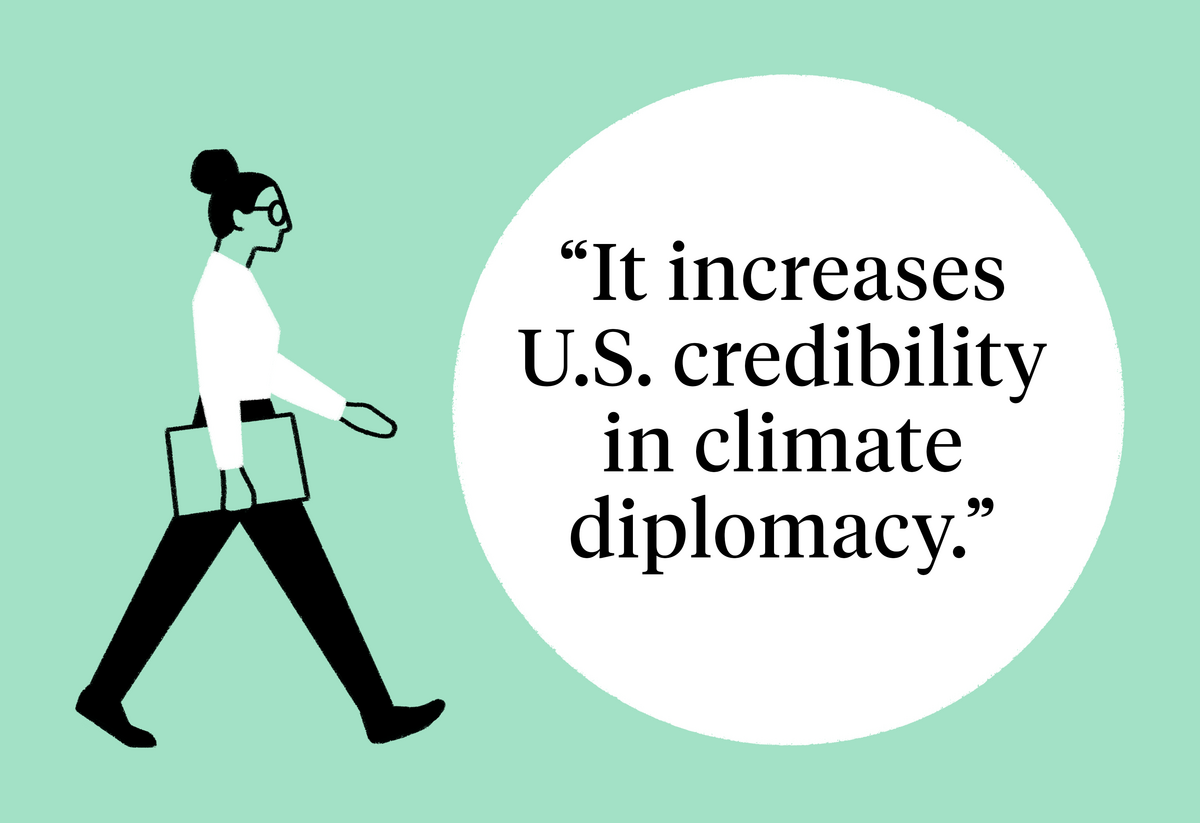Economics Feb 8, 2023
Podcast: How Last Fall’s Climate Bill Is Creating Opportunities for Businesses
With major incentives starting to kick in, here’s how the legislation is poised to affect the economy.

Though a big chunk of the Inflation Reduction Act is intended to fight global warming, it won’t actually do much to decrease the world’s overall emissions—but it’s likely to entice more U.S. businesses to be a little more “green.”
“This law, I would argue, creates some significant incentives and opportunities for the U.S. to build a robust climate economy,” says David Besanko, the IBM Professor of Regulation and Competitive Practices at Kellogg.
And if the U.S. is leading the charge on confronting climate change, other countries may very well follow suit, Besanko says.
In this episode of The Insightful Leader, Besanko explains what businesses should know about last fall’s climate bill.
Podcast Transcript
Laura PAVIN: Back in August of last year, the Biden administration’s most important piece of legislation passed the Senate: the Inflation Reduction Act.
CLIP of newscast from Senate floor IRA passage: [applause] It seems as if we have confirmation from the Vice President, herself, the Inflation Reduction Act has, in fact, passed today.
PAVIN: The bill aims to do a lot of things, like reduce inflation, boost GDP, and reduce the deficit. But the part of the bill that’s gotten a lot of buzz is its aim to fight global warming. Only … here’s something curious:
David BESANKO: This will reduce U.S. emissions. But there’s still a lot of other emissions coming from all over the world. China, Europe, India, and the rest of the world—the Inflation Reduction Act is arguably not going to have much of an impact on any of those.
PAVIN: That’s David Besanko. He’s a microeconomist who recently spoke at an Insightful Leader Live event about the Inflation Reduction Act. But even though the bill doesn’t make much of a dent in the world’s overall emissions, Besanko thinks the IRA is a huge deal for a couple of reasons.
BESANKO: First of all, there are some very important, innovative policy provisions in this law. The second is that this law, I would argue, creates some significant incentives and opportunities for the U.S. to build a robust climate economy.
PAVIN: Welcome to the Insightful Leader. I’m Laura Pavin. Today we’re going to dig into Besanko’s arguments for why the IRA is a big deal, how it could impact the economy, and what opportunities it’s creating for business leaders. That’s next.
...
PAVIN: Besanko thinks the IRA is revolutionary in part because of just how innovative it really is.
Specifically, it’s designed to incentivize companies to reduce emissions in a way that’s a real departure from previous policy efforts.
BESANKO: The kind of the textbook approach is to actually impose some sort of fee or some sort of tax.
PAVIN: Think, for example, of a carbon tax: companies get taxed for emitting CO2 past a certain cap. Not surprisingly, this sort of approach has faced a lot of pushback from industry leaders. So the IRA takes a different approach.
BESANKO: The IRA, with one notable exception, doesn’t go in that direction. Instead the IRA basically motivates firms to reduce carbon emissions in one way or another through various kinds of subsidies or tax credits.
PAVIN: It gives a business positive financial reasons to reduce its carbon footprint. A carrot instead of a stick. And what’s especially exciting to Besanko is the wide variety of different tax credits that are offered.
BESANKO: [montage] There’s production tax credits for electricity produced with renewable sources like wind or solar power; there are tax credits for commercial buildings that deploy renewable technologies like solar panels; there’s a new qualified commercial clean vehicle tax credit, which is available to businesses that, essentially, if they have fleets of trucks or fleets of automobiles, if they electrify those fleets, they get a tax credit for the new vehicles that they purchase.... [fades out]
PAVIN: The list goes on and on, but the point is that the sheer number and variety of incentives means they will apply to a wide array of businesses and industries. So even if you don’t typically think of yourself as being in an energy-intensive industry, it’s quite possible there is a tax credit that would benefit your business and simultaneously reduce your emissions.
In fact, now that we’re in 2023, businesses can start applying for many of these incentives, like commercial electric-vehicle purchases.
Even fossil-fuel companies stand to benefit from these incentives.
BESANKO: And so what this does is it creates incentives. Fossil-based electricity producers define ways to eliminate emissions, such as retrofitting natural-gas plants with carbon-removal technologies, or building new natural-gas plants that have direct air capture associated with them. So this is, I think, a more powerful incentive.
PAVIN: By emphasizing the carrot instead of the stick—a reward instead of a punishment—Besanko thinks the IRA will be good for the climate—and for businesses, too.
...
PAVIN: The other aspect of the IRA that Besanko is a big fan of is how it’s a catalyst for green projects. For one, it injects a whole lot of money into places that are ripe for investment.
BESANKO: It provides $27 billion of competitive grants to state, local, and tribal governments, and nonprofit institutions.
PAVIN: The IRA allocates $27 billion to create a “green bank” that will offer low-cost financing for clean energy projects, with a special emphasis on communities that are in more rural parts of the country, or for historical reasons were left out of the conversation when it came to green infrastructure and environmental degradation. The fine print on eligibility requirements has not yet been made clear, but still...
BESANKO: This is a big deal, not only because it provides additional capital for projects that are socially valuable potentially, but which could not, on their own, attract sufficient private capital to be viable.
PAVIN: Industry leaders might be hesitant to invest in, say, a project that will serve a smaller population and thus take a long time to get a return on the investment. But with some up front capital…
BESANKO: This actually can provide the financing needed to actually get those projects off the ground.
PAVIN: So, for example, some of that money could be used to install solar panels on the rooftops of homes in disadvantaged communities.
And what’s really cool is this funding works hand-in-hand with the tax credits. So let’s say you’re a startup with an innovative green technology. With these IRA grants, you get a few things: you get access to some of those billions of dollars if you partner with one of these underserved communities; you grow your user base to include these communities you couldn’t afford to invest in before; and along the way, you can benefit from tax credits by reducing your emissions as you grow. Not a bad deal!
Now, the final piece in this economic puzzle for Besanko is the IRA’s emphasis on domestic production.
BESANKO: So for example, in order for an electric-vehicle purchaser to qualify for the $7,500 tax credit that you can qualify for, the electric vehicle has to be assembled in the U.S. Fifty percent of the battery components in the vehicle starting in 2023 have to be manufactured in the U.S. That percentage actually goes up to a hundred percent by 2029. Forty percent of the minerals that go into the battery starting in 2023 have to come from the U.S. That percentage goes up to 80 percent in 2027.
PAVIN: Now, not everyone is a fan of these restrictions, including traditional allies in Europe. They say the IRA creates trade barriers that could hurt European electric-vehicle producers. In fact, just recently the European Union announced their own proposals to rival the Inflation Reduction Act.
But at least for American businesses, it represents a huge opportunity for a lot of companies—including ones that you may not even think of.
BESANKO: One thing that this could do is it could spawn a much bigger domestic battery-recycling industry, because you can actually make batteries by sourcing new minerals, but you can also make batteries by recycling existing batteries. And so firms that are operating kind of in that space may have some expanded opportunities here in the United States.
...
PAVIN: Besanko believes this combination of incentivizing existing companies and spurring the creation of new technology can lead to a thriving green economy in the U.S. And there are a lot of reasons that’s desirable.
BESANKO: First of all, it allows the United States better control over its own fate in global energy markets and buffers the U.S better from oil-price shocks.
PAVIN: Remember when gas prices soared in the fall of 2022? It was apparent how painful it can be for consumers when your energy supply depends on foreign oil. But it made things more expensive to businesses as well. So having a consistent and arguably cheaper energy supply domestically will likely help industry in the long run and prevent sudden changes to the market caused by political situations.
But in addition to that, Bensanko thinks the IRA will help improve the U.S’s standing on climate change.
BESANKO: It increases U.S. credibility in climate diplomacy. It enables the United States to better position itself as a leader in working to reduce global warming.
PAVIN: This is also good for businesses. By spurring innovation at home and showing that the U.S is a leader in green technology and infrastructure, it likely means other countries could turn to us for that technology. Especially countries with emerging markets.
BESANKO: And so the United States, if it has a lot of different kinds of climate activities and climate sectors and industries, you know, kind of innovating and perfecting and producing, that gives the United States the ability to transfer this technology to help other countries reduce their emissions.
PAVIN: In other words, if we succeed, the whole world could benefit.
[CREDITS]
PAVIN: This episode of The Insightful Leader was written and mixed by Andrew Meriwether. It was produced by Andrew Meriwether, Laura Pavin, Jessica Love, Emily Stone, Fred Schmalz, Maja Kos, and Blake Goble. Special thanks to David Besanko. Want more The Insightful Leader episodes? You can find us on iTunes, Spotify, or our website: insight.kellogg.northwestern.edu. We’ll be back in a couple weeks with another episode of The Insightful Leader Podcast.


